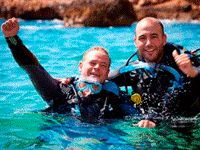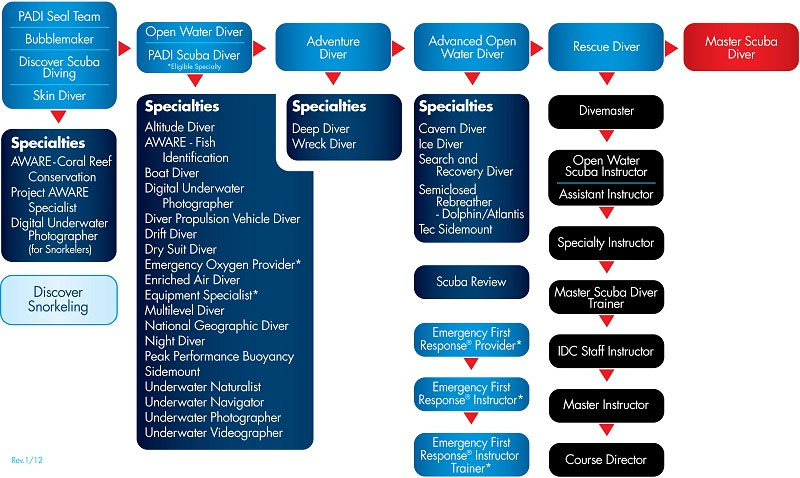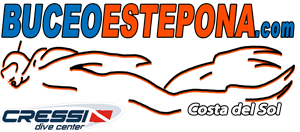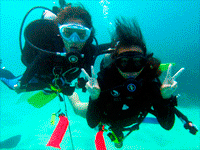
Diving Courses and programs
PADI diving courses in Estepona
You can decide which are your types of diving courses from all below. If you want to learn to dive or just try to feel underwater breathing, you just have to choose your program. It’s easy, we’ll guide you on which is the best path you can choose to achieve your goal. Maybe you just want to try new sensations or become a PADI diver, but have you thought about dedicating yourself professionally to diving? Live what you like and your office is the sea, would not be bad, right?
|
|
||

What is or does PADI mean?
Let’s not give more thought to the matter, PADI stands for the Professional Association of Diving Instructors or, in Spanish, Professional Association of Diving Instructors. The association was founded by John Cronin and Ralph Erickson in 1966. This is some time ago.
PADI is the main diving school worldwide both in importance and in number of members. But PADI also endorses a series of certifications that certify the diving level of the diver. These range from the lowest levels of learning to the most advanced.
The history
The largest diving organization in the world, PADI, was created in 1966 from the dream of two friends in Illinois with a bottle of Johnnie Walker. It is true!!
John Cronin, a dive equipment salesman who worked for U.S. Divers, and Ralph Erickson, an educator and swimming instructor, were concerned about the diving industry. They were clear that the diving certification federations that existed until then were unprofessional, did not use modern teaching and made it unnecessarily difficult and complex for people to start in that sport. John and Ralph knew there had to be a safer and easier way for people to learn to breathe underwater.
In 1966, John brought a bottle of Johnnie Walker black tag and $ 30 US to Ralph’s apartment in Morton Grove, Illinois. They decided that it was time to start creating a diving education organization. John insisted that the word “professional” be in the name of the company. Ralph wanted an “association of dive instructors.” After a few rounds of whiskey, the name PADI: Professional Association of Diving Instructors was born.
Its objective? offer more people the opportunity to enjoy the underwater world by offering an adequate and valid training for diving with autonomous equipment to create safe divers who dive regularly and safely.
The Underground Office
The initial meetings took place at several restaurants in Morton Grove and Niles, Illinois. In a few months, Cronin prepared a part of the basement of his house on Main Street in Niles to make it the headquarters of PADI. After some time she hired her neighbor from the house next door to be a part-time secretary. His son, Brian, filled and closed the envelopes.
A logo of a Torch
While looking for new ideas for designing a logo, John said he wanted something classy like the look of National Geographic. Years later, in an interview, Ralph said that idea changed the way he was considering this small two-person company. At that time, he could see a great vision for PADI. Ralph was responsible for designing the first PADI logo – a diver with a torch on a globe. This logo was later retouched to become the current famous PADI logo.
System
The PADI learning method mixes theory and practice. The theory was taught through books, DVDs or, but already more and more frequently, and consequently with new technologies, in online courses with the PADI Touch system. On the other hand, the practical part is performed in the water under the supervision of an instructor. The courses are divided into modules and an evaluation is required to achieve any certification.
PADI certification courses in Estepona Diving
At Buceo Estepona we give our students a wide range of courses and PADI rograms. Now I will give you some examples. but first let’s see what is the difference between COURSE and PROGRAM
A diving course is nothing more than an evaluation of techniques. The instructor shows them and the student must demonstrate that he masters them. Once all the exercises and theoretical parts have been passed, the instructor will certify the student with an international certification. The card will be valid for diving in 95% of all countries in the world. Instead, a program is based on teaching the basics, or remembering forgotten techniques and after all this there will be no certification. Therefore, a course certifies as a diver of any level and will be recognized in any dive center and a diver who has made a program will not be recognized as such.
Examples of courses:
PADI Discover Scuba Diving:
Activity for all those people who have never dived and want to have their first underwater experience. It can be done in a pool, in the sea in confined waters or organize a double program, first in a pool to get confidence and then in the sea.
PADI Scuba Diver:
It is the previous course to the PADI Open Water Diver level. Ideal for people who do not have much time to complete the course. Although we always recommend doing the OWD course.
PADI Open Water Diver:
This PADI course is the most popular and certifies to obtain the open water scuba certification. You can descend to 18m. You can also dive without having to be accompanied by an instructor, only with your partner with the same degree or higher
PADI Adventure Diver:
Designed for those who already have the PADI Open Water Diver certification and want to improve their technique. This course is halfway to the OWD and the advanced course. But just like the Scuba Diver is designed for people who have little time.
PADI Advanced OpenWater:
Ideal for those divers who already have the PADI Open Water Diver certification and wish to improve their techniques. After this course the diver can descend to 30m depth.
PADI Buceo profundo:
Once you are an advanced diver, you can choose to take this specialty course. Being a specialist in deep diving, you will be able to dive to a depth of up to 40 meters. This is the legal maximum for recreational diving.
If you have more questions please contact us and we will clarify it







